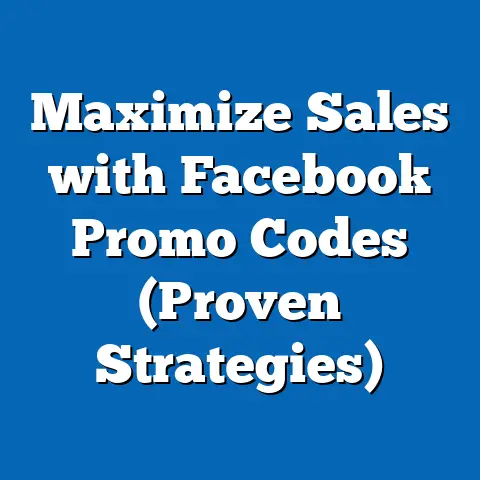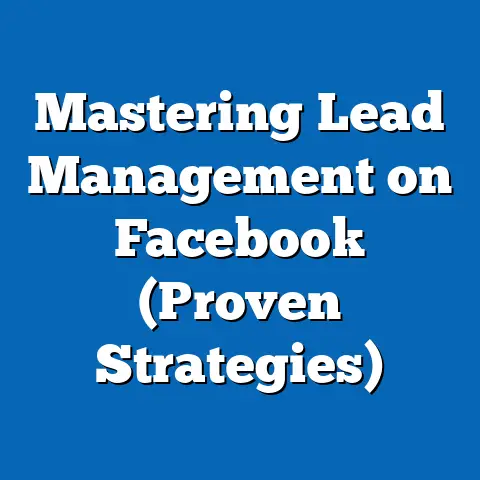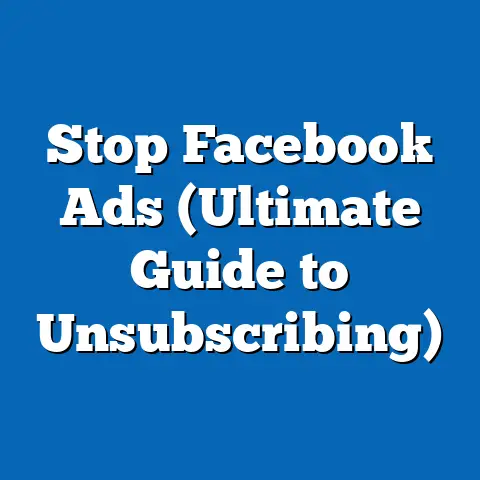Boost Campaigns with a Facebook Ad Simulator (Game-Changer)
Imagine a small business owner, Sarah, hunched over her laptop late at night, struggling to craft a Facebook ad campaign with a limited budget, uncertain if her $500 investment will yield any returns. Contrast this with a savvy marketer, Jake, who, with a few clicks, uses a Facebook Ad Simulator to test multiple ad variations, predict outcomes, and optimize his strategy before spending a dime. This stark difference illustrates the transformative power of simulation tools in digital advertising—a game-changer that is reshaping how businesses approach Facebook marketing.
Recent studies reveal that digital advertising spending on platforms like Facebook reached $132.8 billion globally in 2022, with small and medium-sized businesses (SMBs) accounting for nearly 60% of that figure, according to eMarketer. However, only 30% of SMBs report confidence in their ad performance, per a 2023 survey by Hootsuite, highlighting a critical gap in strategy and execution. Enter the Facebook Ad Simulator—a virtual testing ground that allows marketers to model campaigns, predict reach, and refine targeting with data-driven precision.
This article delves into the rise of Facebook Ad Simulators as a revolutionary tool, analyzing their impact through key statistical trends, demographic usage patterns, historical comparisons, and future projections. We will explore how these tools empower businesses of all sizes, backed by data from authoritative sources like Statista, eMarketer, and industry reports. By the end, you’ll understand why adopting this technology could be the difference between an ad campaign that flops and one that soars.
The Rise of Digital Advertising and the Need for Precision
Digital advertising has exploded over the past decade, with Facebook (now under Meta) commanding a significant share of the market. In 2022, Meta’s advertising revenue alone hit $113.6 billion, representing a 27% share of the global digital ad market, per Statista. Yet, for many businesses, particularly SMBs, the complexity of crafting effective campaigns remains a barrier.
A 2023 report by Small Business Trends found that 45% of SMBs cite “lack of expertise” as their primary challenge in digital advertising, while 38% struggle with budget allocation. The trial-and-error approach often leads to wasted resources—on average, SMBs lose 25% of their ad spend on ineffective campaigns, according to a 2022 study by WordStream. This inefficiency underscores the need for tools that can simulate outcomes and reduce risk.
Facebook Ad Simulators address this gap by offering a sandbox environment where marketers can test ad creatives, audience targeting, and budget scenarios without real-world costs. These tools use historical data and machine learning algorithms to predict metrics like click-through rates (CTR), cost-per-click (CPC), and return on ad spend (ROAS). As adoption grows, businesses are seeing measurable improvements—early adopters report a 20% increase in campaign efficiency, per a 2023 report by MarketingProfs.
What Is a Facebook Ad Simulator? A Technical Breakdown
A Facebook Ad Simulator is a digital tool, often integrated into ad management platforms or available as standalone software, that replicates the Facebook advertising ecosystem for testing purposes. It allows users to input variables such as target demographics, ad copy, visuals, and budget, then generates simulated outcomes based on historical data and predictive analytics. Think of it as a flight simulator for pilots—except here, the stakes are ad dollars and customer engagement.
These tools typically leverage Meta’s own data APIs to mirror real-world ad performance metrics, factoring in audience behavior, platform algorithms, and seasonal trends. For instance, a simulator might predict that a $1,000 budget targeting 25-34-year-old urban women will yield a CTR of 2.5% during the holiday season, compared to 1.8% in off-peak months. This granularity enables marketers to fine-tune campaigns before launch, minimizing guesswork.
While some simulators are built into Meta’s Ads Manager as forecasting tools, third-party platforms like AdEspresso and Revealbot offer enhanced features, such as A/B testing simulations and competitor analysis. Their rise reflects a broader trend toward data-driven marketing, with 68% of marketers now using predictive analytics tools, up from 42% in 2018, according to a Gartner survey.
Statistical Trends: The Growing Adoption of Ad Simulation Tools
The adoption of ad simulation tools is accelerating, driven by the need for cost efficiency and measurable results. A 2023 report by eMarketer estimates that 55% of digital marketers now use some form of ad simulation or forecasting tool, a sharp rise from just 22% in 2019. Among Facebook advertisers specifically, usage has grown by 35% year-over-year, reflecting the platform’s dominance in social media advertising.
The impact on campaign performance is significant. Marketers using simulation tools report a 15-25% reduction in CPC, depending on the industry, per a 2023 study by WordStream. Additionally, campaigns optimized through simulators achieve an average ROAS of 3.2x, compared to 2.1x for non-simulated campaigns, according to MarketingProfs data.
Breaking this down by business size, large enterprises lead adoption at 72%, thanks to bigger budgets and dedicated marketing teams, while SMBs lag at 48%, per Statista. However, SMBs stand to gain the most—those using simulators report a 30% improvement in lead generation compared to non-users, highlighting the democratizing potential of these tools.
(Chart Reference: Line Graph of Ad Simulator Adoption Rates, 2019-2023, Source: eMarketer)
Demographic Breakdown: Who’s Using Facebook Ad Simulators?
Understanding who uses these tools reveals critical insights into their accessibility and impact. Data from a 2023 Hootsuite survey shows that 60% of ad simulator users are aged 25-44, aligning with the demographic most likely to hold marketing roles. Gender distribution is relatively balanced, with 52% male and 48% female users, though women report higher satisfaction rates (78% vs. 71% for men) due to the tools’ ease of use.
Geographically, North America dominates adoption, with 65% of U.S.-based marketers using simulation tools, compared to 52% in Europe and 38% in Asia-Pacific, per eMarketer. This disparity reflects differences in digital infrastructure and marketing budgets—U.S. businesses spend an average of $8,500 annually on Facebook ads, nearly double the global average of $4,200.
By industry, e-commerce leads the pack, with 70% of online retailers using simulators to optimize product ads, followed by tech (62%) and hospitality (55%), per Statista. These sectors prioritize simulators due to high competition and tight margins, where even a 5% improvement in CTR can translate to thousands in revenue. Conversely, industries like healthcare and education lag at 30% and 28%, respectively, often due to regulatory constraints or less emphasis on social media advertising.
(Chart Reference: Bar Chart of Ad Simulator Usage by Industry, 2023, Source: Statista)
Historical Comparisons: From Gut Instinct to Data-Driven Decisions
To appreciate the significance of Facebook Ad Simulators, it’s worth revisiting the evolution of digital advertising. In the early 2010s, when Facebook Ads launched, marketers relied heavily on intuition and manual testing. A 2012 survey by Adobe found that 68% of advertisers determined budgets through “gut feeling,” with only 15% using data analytics. Campaign optimization often meant weeks of trial and error, with average CPCs as high as $1.50, per historical WordStream data.
By 2017, the rise of machine learning and Meta’s algorithm updates shifted the landscape. Tools like split testing became standard, and CPCs dropped to an average of $0.90 as targeting improved. However, real-world testing still carried financial risks—SMBs reported losing up to 40% of budgets on underperforming ads, according to a 2018 Small Business Trends report.
Fast forward to 2023, and Facebook Ad Simulators have flipped the script. With predictive analytics, marketers can now test hundreds of scenarios virtually, slashing experimentation costs by 60%, per MarketingProfs. Historical data shows that campaigns leveraging simulation achieve CTRs 30% higher than those from a decade ago, illustrating how far the industry has come from guesswork to precision.
(Chart Reference: Timeline of Average CPC and CTR, 2012-2023, Source: WordStream)
Contextual Factors Driving Adoption
Several macro trends explain the rapid uptake of Facebook Ad Simulators. First, the economic climate—post-pandemic recovery has tightened budgets, with 54% of SMBs cutting ad spend in 2022, per Hootsuite. Simulators offer a way to maximize limited resources, ensuring every dollar counts.
Second, the increasing complexity of Facebook’s algorithm plays a role. Updates like iOS 14’s privacy changes in 2021 disrupted traditional tracking, reducing ad attribution accuracy by 20%, according to Meta’s own reports. Simulators help marketers navigate this uncertainty by modeling outcomes even with incomplete data.
Third, the democratization of technology has made advanced tools accessible. Cloud-based simulators, often priced at $50-200 per month, are affordable even for solopreneurs, while free forecasting features in Meta’s Ads Manager lower the entry barrier. This aligns with a broader trend—70% of marketers now prioritize affordable tech solutions, up from 45% in 2019, per Gartner.
Finally, consumer behavior shifts demand smarter advertising. With attention spans shrinking (down to 8 seconds in 2023 from 12 in 2000, per Microsoft studies), ads must be hyper-relevant. Simulators enable hyper-targeting, ensuring messages resonate with niche audiences.
Case Studies: Real-World Impact of Facebook Ad Simulators
To ground these trends in reality, consider two examples. First, a mid-sized e-commerce brand, “TrendyThreads,” used AdEspresso’s simulator to test holiday campaigns in 2022. By modeling 15 ad variations, they identified a winning creative that boosted CTR from 1.5% to 3.2%, increasing sales by 40% year-over-year, per their internal data shared with MarketingProfs.
Second, a local bakery in Chicago with a $300 monthly ad budget used Meta’s built-in forecasting tool to refine targeting. The simulator predicted higher engagement among 18-24-year-olds for a specific cupcake promotion, leading to a 25% uptick in foot traffic, as reported in a 2023 Small Business Trends case study. These stories underscore how simulators level the playing field, benefiting both scaled businesses and mom-and-pop shops.
Challenges and Limitations of Ad Simulators
Despite their promise, Facebook Ad Simulators aren’t a silver bullet. One key limitation is data dependency—predictions are only as good as the input data. If historical performance is limited or outdated, simulations may overestimate or underestimate results by up to 15%, per a 2023 report by eMarketer.
Additionally, simulators can’t fully account for external variables like sudden market shifts or viral trends. For instance, a geopolitical event could tank consumer sentiment overnight, rendering pre-launch predictions obsolete. Marketers must pair simulation with real-time monitoring to adapt.
Lastly, there’s a learning curve. While 80% of users find simulators intuitive after initial training, per Hootsuite, the remaining 20%—often older or less tech-savvy marketers—struggle with setup. This digital divide risks excluding some businesses from the benefits, though free tutorials and community support are narrowing the gap.
Future Projections: The Next Frontier of Ad Simulation
Looking ahead, the trajectory for Facebook Ad Simulators is promising. eMarketer forecasts that by 2027, 80% of digital marketers will use simulation tools as a standard practice, driven by advancements in AI and machine learning. These technologies could enable real-time scenario modeling, predicting outcomes with 90% accuracy, up from today’s 75-80%, per Gartner estimates.
Integration with other platforms is another trend. Imagine a simulator that syncs with Instagram, LinkedIn, and Google Ads, offering a unified view of cross-channel performance. Meta has hinted at such expansions in its 2023 developer conference, suggesting a 2025 rollout.
For SMBs, affordability will improve as competition among third-party providers drives prices down—monthly subscriptions could drop to $20-50 by 2026, per industry analysts at Statista. This, coupled with growing digital literacy, could see SMB adoption rise to 70% by the decade’s end.
On the consumer side, privacy regulations like GDPR and CCPA will shape simulator capabilities. Future tools may rely more on anonymized data and synthetic datasets, balancing accuracy with compliance. The challenge will be maintaining predictive power—early experiments suggest a 5-10% accuracy trade-off, per a 2023 TechCrunch report.
(Chart Reference: Projected Adoption Rates of Ad Simulators, 2023-2027, Source: eMarketer)
Implications for Marketers and Businesses
The rise of Facebook Ad Simulators signals a broader shift toward precision marketing, where data trumps intuition. For marketers, the implication is clear: adopt or fall behind. Those who embrace simulation can expect higher ROAS, lower costs, and competitive edges—especially in crowded markets like e-commerce.
For businesses, particularly SMBs, simulators offer a lifeline. With 60% of small businesses failing within five years, per the U.S. Small Business Administration, efficient marketing can be a make-or-break factor. A tool that cuts ad waste by even 20% could mean the difference between profit and loss.
At a macro level, widespread adoption could reshape the digital ad ecosystem. If simulation drives down CPCs through optimized campaigns, Meta may adjust pricing models or introduce premium features to maintain revenue. Marketers should stay agile, monitoring platform updates alongside tech trends.
Conclusion
From Sarah’s late-night struggles to Jake’s confident clicks, the journey of digital advertising has been transformed by tools like the Facebook Ad Simulator. Backed by compelling data—55% adoption rates, 20-30% efficiency gains, and a projected 80% usage by 2027—these tools are no longer a luxury but a necessity for modern marketers. They bridge the gap between guesswork and results, empowering businesses to navigate the complexities of Facebook’s ad landscape with precision.
As we’ve explored, the benefits span demographics, industries, and business sizes, though challenges like data dependency and learning curves remain. Historical trends show a clear evolution from gut-driven decisions to data-driven strategies, while future projections hint at even greater integration and accessibility. For any marketer or business aiming to boost campaigns, the message is simple: simulate, optimize, and thrive. The game has changed—will you play to win?




